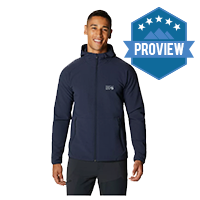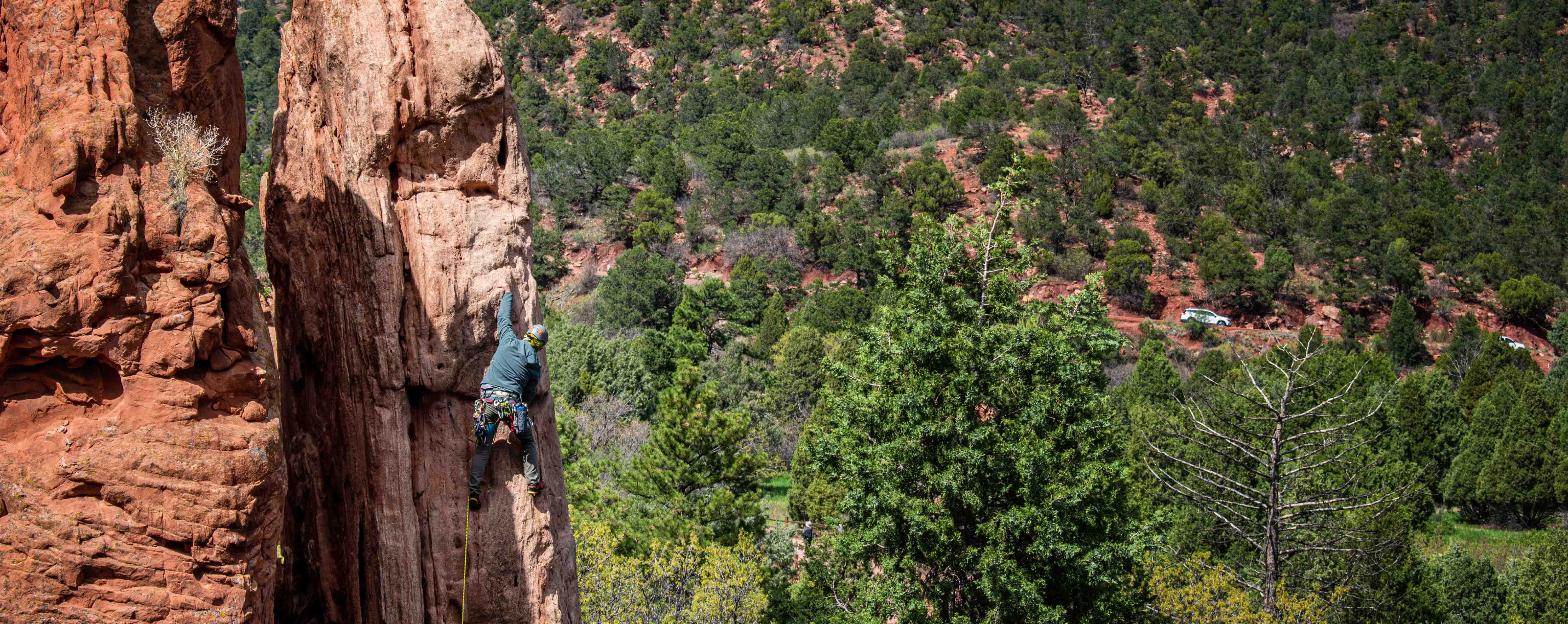ProView – Mountain Hardwear Keele Grid Hoody
Being a climbing guide in the Spring means my time is split between the thunderous and wet landscape of the Pikes Peak region of Colorado and the arid and temperamental desert of Moab. Although my guided activities may be the same, my clothing and layering can be dramatically different depending on where I am. The Keele Grid hoody from Mountain Hardwear found itself in my backpack regardless of where I was tying in that day.
Mountain Hardwear Keele Grid Hoody

Product Name: Mountain Hardwear Keele Grid Hoody
Product Description: The next evolution of an invention that's been brilliant from the start, the Keele™ Grid Hoody takes the durable doubleweave this family style is known for and adds a brushed grid backer to draw moisture away from your skin as you sweat. Helping maintain comfort from the inside out, even as you move beyond your comfort zone, this fabrication ensures peace of mind from the get-go, using bluesign®-approved recycled materials and non-toxic waterproofing that's as gentle on the environment as it is on you.
Offer price: $150 MSRP
-
Quality
(4.5)
-
Features
(4)
-
Fit
(5)
-
Durability
(5)
-
Eco-Friendly
(4.5)
Summary
The Keele Hoody is a well-functioning hoody for the everyday wearer no matter what the weather throws at you.
Overall
4.6Pros
- Brush backed fabric is super comfy
- Hood fits over a climbing helmet nicely
- Breathable
- PFC-free DWR coating
Cons
- Cuffs are wide, which is less-than-ideal for active use
- Packaged in a Plastic #4 bag. Recyclable, probably, but let’s just get away from mass use of plastic bags.
Springtime in the desert and my work-home of Colorado Springs can provide wide-changing weather. I might leave the 90-degree heat of Moab behind to arrive in Colorado Springs and six inches of snow. This might make climbing difficult, but it makes packing even more challenging. When you are living out of a duffle bag to guide, your clothes must be functional, professional, and need to fit well.

Fit and Comfort
I was expecting this hoody to be thinner and less versatile, but I was over-the-moon with its thickness and density. I ended up reaching for this hoody more often than others because it provided a comfortable and cozy jacket to spend the day in. The sizing for the jacket was spot on though I did find it a tad baggier than I would like. At 6’2”, 225 lbs. and +2.5” wingspan, I typically wear a Large in Mountain Hardwear clothing, and this jacket was no different. I thought the cuffs were finished nicely but they are not tapered which I prefer for an activity-based jacket.
If you are into shaving ounces, then this hoody probably is not for you: it weighs in at 17.3 ounces. This is much heavier than other Mountain Hardwear hoody alternatives, but this extra weight comes from the double-weave brushed-back fabric that gives this hoody its signature cozy feel. In my opinion, you probably will not notice the extra 3 or 4 ounces but you will notice how this hoody wraps your torso in warm and soft comfort.
Performance
Could a hoodie that I felt was made for comfort also perform well? I was skeptical and this skepticism kept me from wanting to have this as my sole layer on more technical, weather-iffy days. The day I finally grabbed this hoodie instead of my typical go-to was the best day to really see how this hoodie would stack up. I had 40-degree morning temps on my commute on a motorcycle, shaded climbing, multipitch belays where the sun finally hits you, wind, and rain all experienced on this single day of guiding — and I only had the Keele Hoody along. The double-weave fabric is a tight enough weave that the wind does not go right through it and the brushback interior helps keep you warm and comfortable. The sun finally broke through the clouds when I was sitting at the belay 200 feet off the ground and I went from shaded climbing to full sun. I was pleased with how well this jacket breathed and wicked moisture despite no easy way to shed the layer while mid-climb. I never felt too swampy as I climbed with this hoodie on in the sun. When the rain came, the DWR finish was way better than expected: the rain beaded and rolled off like it was nothing else. The DWR finish was able to outlast the 30-minute thunderstorm without being soaked through.

Friendliness to the Earth
How companies source and manufacture clothing is becoming an increasingly serious question to ask as the fashion/clothing industry is often awarded second place in the global polluter awards. As consumers, you are not often given much of a choice let alone any information about how a company is sourcing and manufacturing the clothing that you are purchasing. Mountain Hardwear seems to be focusing on putting this information at the forefront of their product descriptions which will help consumers purchase products that are contributing less to the problem than others might be. The Keele Hoody has Bluesign approved fabric. This approval means that the fabric has been monitored at every step in the supply chain—from chemical formulation to finished product—to keep chemicals of concern out of the process. The fabric is 90% recycled polyester and the DWR finish is PFC-free. Why is PFC (per- and poly-fluorinated chemicals) free DWR (durable water repellent) important? It is widely used for waterproofing of materials and breaks down very slowly in the environment. It has been found in measurable amounts in snow, ice, and water, and there is some evidence that it can cause harm to the wearer. Whether this impact is large or minuscule, we as consumers and users of our technical clothing should be putting a bit more thought into the necessity of man-made chemicals to help our recreational opportunities be more pleasant.
Final Word
The Keele Hoody is a great addition to someone that finds themselves outside in any weather or any sport. The fit and function of this hoodie will prove itself time and time again as your go-to piece. If you are looking for an expedition-focused piece of clothing, then this might not be your best choice but for the other 99.5% of your life, this jacket will serve you well.
Shop Mountain Hardwear on Outdoor Prolink. Not a member? Apply today!
About the Gear Tester

Patrick Betts
Patrick Betts is the Technical Director at Front Range Climbing Company and is based in Moab, Utah. He has been in the Outdoor Industry since 2009 and guides year-round in Colorado, Utah, and beyond. When he is not guiding, you will find him traveling to climbing destinations around the world. Patrick is an experienced adventure photographer who enjoys taking photos of people pushing their own limits and capturing the landscapes of the areas that rock climbing takes you. Follow along @adventurethrulens









